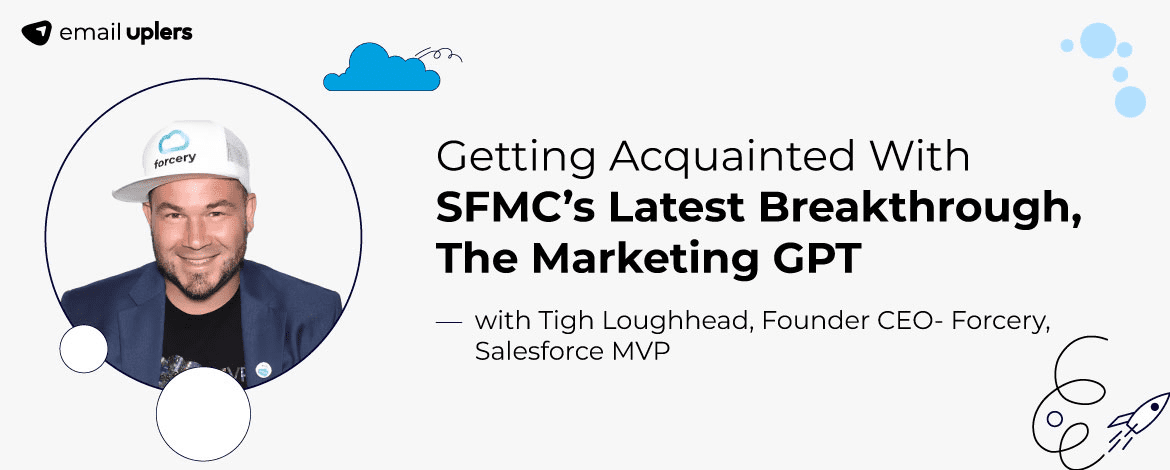Expert Interview Series: Part 10
In recent years, generative AI has led the way in transforming the landscape of automated, data-intensive marketing. Today, leading companies leverage generative AI to not only fast-track the customer’s journey up the sales funnel but to vitalize customer experience at each touch point. Thanks to AI, companies can now afford to palm off long-winded sales operations and prioritize engaging with customers at a deeper level.
In June this year, Salesforce launched Marketing GPT with a view to aggrandize, via AI-powered data enrichment, the liaison between companies and their customers. To know more about this and about the potential of generative AI at large, we got in touch with Tigh Loughhead, an expert in marketing technology, from Salesforce. Over to him!


In what ways do you think generative AI will transform the customer experience within Salesforce Marketing Cloud?
Tigh: I think broadly, generative AI will make for more meaningful moments in customer marketing. I (and many others) have spoken about this quite a bit, but the megaphone, mass-marketing’s effectiveness has diminished, while modern marketing success is all about context and relevance with today’s consumer.
However, delivering messages that mean something to a consumer, especially at scale is actually very difficult. The proliferation of signals around buyer behavior continue to increase exponentially, but assimilating all of that data, segmenting audiences, testing messaging and iteratively optimizing takes analytics infrastructure, data warehousing, data science and an army of marketing ops professionals to execute on an idea or a campaign.
Linear advertising, or the traditional “spray and pray” approach in marketing is just easier to do, but generative AI is already increasingly assisting with harmonizing data, segmenting customers, and iteratively optimizing campaigns with messaging that matters. Marketing Cloud, enhanced by generative AI, will enable many more companies to start serving more targeted messaging, relevant to customers, when they’re ready to buy.



How do you think Marketing GPT helps to understand the target audience to create content that resonates with them?
Tigh: Segmentation and messaging go hand in hand, but really are supported by two different Salesforce features called ”Segment Creation” and “Email Content Creation.“
The effectiveness of Marketing GPT’s segmentation capabilities is rooted in the use of Salesforce Data Cloud, which assimilates behavioral interactions (first-party data), sales (CRM) data, and third-party paid media data in a unified customer profile. Basically, we often have a very fuzzy idea of exactly who a customer is, unless we reconcile all of the information in a single source of truth. Marketing GPT connects these data points, automatically resolving customer identities and refreshing segments, creating rich and real-time audiences.
Content on the other hand, can be improved by past performance, or based on user prompts to use Marketing GPT to generate messaging in a certain style or tone using the core OpenAI’s large language models, or LLMs.


How is Marketing GPT helping to make data-driven decisions in marketing?
Tigh: I’ve always disliked the term “artificial” intelligence, and I don’t like the term “generative” either. I think both are misnomers that obfuscate what the technology really does. There’s nothing “artificial” about AI; if anything AI should stand for “Assisted” Intelligence. Similarly, there is absolutely nothing truly “generative” about LLMs; they’re just algorithms getting very good at making predictive outputs based on inputs.
The more inputs there are, the better the predictions become and the better the results. Marketing GPT will reduce the drag of labor-intensive, siloed data analysis and the overhead of repetitive marketing operations, and enable marketing practitioners to focus on higher-level strategy decisions, using more robust and accurate datasets than ever before.
The real benefit of AI is not that it creates anything new, but the patterns that it can recognize at scale that are beyond the capabilities of the individual or a small marketing team.


Will Marketing GPT contribute to building a strong online presence through social media management?
Tigh: Marketing GPT will help brands better know their customer, and deliver more relevant social campaign messaging that will reinforce a company’s online presence. I also think that social media is an amazing conduit for commerce and service, poised to grow as more consumers expect an omni-channel customer experience. Salesforce Commerce and Service are also both launching features where Einstein GPT / Marketing GPT will assist with communication, escalation and purchasing, and social will play a bigger role in those communication channels.
I also expect social listening to eventually become a part of Marketing GPT, so companies can gauge sentiment and respond to issues in the social channel on which it originated. However, Marketing GPT as it exists today can’t exclusively power social media, because again, an LLM can’t create an authentic experience, but rather than an echo or a deviation of something else that worked (or didn’t) in the past.


How does Marketing GPT leverage its SEO expertise to enhance the visibility of my website in search engine results?
Tigh: Keywords, traffic, relevance, links, content and click-thru rates are all data inputs that factor into SEO and search engine rankings. Average position, conversions, and overall ROI are all data inputs that can and will be fed into AI, so it stands to reason that we’ll be able to optimize or create SEO-rich content using AI tools that improve the search engine visibility of website or a particular page. However, Google has continually adjusted its algorithm to penalize programmatically generated content and always prioritized consumer intent.
I think the more interesting question is will SEO even be relevant in a few years. Sure, companies will still have websites, but I suspect that we’ll be optimizing for conversational AI interfaces instead of search engines, making sure that our prospective customers are getting the answers they need, as opposed to forcing them onto to an online billboard that’s really about the company and (often) not the consumer’s intent.
I expect a massive consumer behavior shift that will render SEO somewhat irrelevant.


Improving the efficiency and effectiveness of marketing campaigns is pivotal. How does Salesforce Marketing GPT contribute toward this?
Tigh: For midsized to larger companies, the responsibility for proving effectiveness of a marketing campaign is often distributed across multiple teams. Many companies have to hire agencies who manage and report on third-party paid media (like Google Ads and Facebook), business analysts to interpret first-party data (website and email), sales managers to surface sales intermediated activity, and then accounting software or a CRO to map deals back through one or more sales and marketing funnels, and how each touchpoint along the way influenced a deal.
In a longer sales cycle, it’s not uncommon for a purchase to result from separate demand generation and conversion optimization campaigns, then MQL BDR/SDR handoff to relationship building campaigns, to upsell or loyalty campaigns. When different internal teams are responsible for demonstrating the impact of one piece of the overall value chain, the effectiveness of each marketing campaign is often lost in the noise.
The true value of a CRM is in mapping the entire business process, surfacing the ability to measure marketing, sales and revenue, and providing levers to adjust successful or unsuccessful processes. Marketing GPT on top of Data Cloud can use these levers at scale either broadly (for example adjusting campaign budgets to drive more revenue) or on a much more granular level (which subject line is driving more email opens) to help marketers manage budgets better and improve campaign performance.


How does Marketing GPT analyze campaign metrics to provide actionable insights?
Tigh: Campaign performance must be tied to KPIs that influence the greater business to provide actionable information. “Segment Intelligence” is an incredible tool that visualizes Salesforce campaign performance metrics. KPI’s like spend, revenue and ROI are visualized on a campaign by campaign basis, contrasted against one another and part of overall marketing spend and company revenue.
Impressions drive awareness and conversions, which drive leads, sales and ultimately ROI. However, ROAS or return on ad spend, can be a challenging metric to obtain, as tracing attribution from ad to deal can be a difficult needle to thread.
Segmentation traces this performance by each Salesforce campaign, displaying high level impact of campaign performance, and allowing companies to strategically adjust marketing initiatives based on those KPIs.


What are the key benefits of leveraging natural language prompts and AI-driven recommendations in audience segment creation?
Tigh: Natural language inputs make complex list and audience building incredibly easy. As a marketer, if I was asked to pull an audience of current clients that live in a particular area, historically I would historically have to cross reference a business deal database with a contact database, hopefully in a CRM. I would need to be handy with spreadsheets, familiar with my company’s data model, and how to run and manipulate reports, which is both time-consuming and not all marketers know how to do.
Using natural language prompts, I can simply provide parameters to Marketing GPT using normal diction, something like “Current clients in Kansas City,” and build a hyper-targeted segment without any of the technical skills I previously needed.
This conversational interface simultaneously increases efficiency of marketing teams, while democratizing data, making targeted and contextual marketing easier for anyone who wants to do it.


How can Email Content Creation powered by Marketing GPT reduce the writing workload for marketers and enhance email engagement?
Tigh: I think marketers, or at least copywriters, are a little worried about Email Content Creation taking their jobs. But personally, I wouldn’t worry about AI won’t taking my job, I worry about another marketer who’s already mastered Marketing GPT replacing me, as AI makes marketers more dynamic and efficient.
Email Content Creation empowers marketers to be much more productive and impactful than ever before. Marketing GPT uses “big data,” analyzing all historical email performance holistically, and suggests subject lines that are predicted to perform better. Marketing GPT can also rewrite or stylize content according to prompts that align messaging to the purpose of a campaign. Salesforce’s new partnership with Typeface can even automatically build templates and components that align with a firm’s brand identity.
Marketing GPT is a toolbox to enhance the capabilities of writers and marketers, to produce more and better engaging content.


How will the combination of Rapid Identity Resolution, Segmentation, and Engagement in Marketing GPT help marketers deliver the right message to customers at the right time?
Tigh: To better know my customer, I need to know who they are, what they’re interested in and how they behave. This sounds simple, but the proliferation of data points around our visitors, our prospects, our leads, our contact and our deals have just exploded. A subscriber isn’t the same thing as a web visitor, which is different than a conversion, a lead or an opportunity.
None of these data points are fixed either. A customer may become a lead, be in another audience and be a website user all at the same time. No one marketer can reconcile these data points in real time around an individual, and then group and serve relevant content to particular cohorts when they’re activated or ready to buy.
Rapid Identity Resolution allows that reconciliation in real time, and then on-the-fly personalization relevant to a consumer on the device, browser or channel they prefer.
No matter how revolutionary AI seems today, it’s still just the tip of the iceberg. Generative AI has a glorious future in marketing, tying as it does the various strands of business intelligence into a cohesive dashboard of at-the-ready controls. How will you integrate generative AI into your business? Let us know in the comments below!







Prajakti Pathak
Prajakti is the Content Lead at Email Uplers. She brings with her a rich content creation experience of over 10 years. A creative mind and a good hold on syntax make her traverse her writing through different forms of content including blogs, interviews, infographics, case studies, etc. While writing is her first love, she’s also an avid birdwatcher.
Swati Fulsunge
Swati is a digital marketing expert at Email Uplers. She has a strong marketing background, and keenly follows developments shaping the technological landscape, especially matters pertaining to Artificial Intelligence. When not at work, she cherishes quality moments with her family and friends.
Leveraging Predictive Analytics in Email Marketing- A Definitive Guide
10 Blink-Stopping Ideas For Announcement Emails